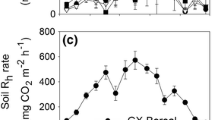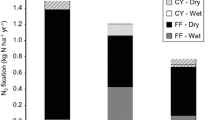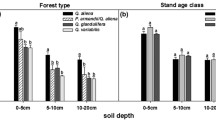Abstract
Forest productivity depends on nutrient supply, and sustained increases in forest productivity under elevated carbon dioxide (CO2) may ultimately depend on the response of microbial communities to changes in the quantity and chemistry of plant-derived substrates, We investigated microbial responses to elevated CO2 in a warm-temperate forest under free-air CO2 enrichment for 5 years (1997–2001). The experiment was conducted on three 30 m diameter plots under ambient CO2 and three plots under elevated CO2 (200 ppm above ambient). To understand how microbial processes changed under elevated CO2, we assayed the activity of nine extracellular enzymes responsible for the decomposition of labile and recalcitrant carbon (C) substrates and the release of nitrogen (N) and phosphorus (P) from soil organic matter. Enzyme activities were measured three times per year in a surface organic horizon and in the top 15 cm of mineral soil. Initially, we found significant increases in the decomposition of labile C substrates in the mineral soil horizon under elevated CO2; this overall pattern was present but much weaker in the O horizon. Beginning in the 4th year of this study, enzyme activities in the O horizon declined under elevated CO2, whereas they continued to be stimulated in the mineral soil horizon. By year 5, the degradation of recalcitrant C substrates in mineral soils was significantly higher under elevated CO2. Although there was little direct effect of elevated CO2 on the activity of N- and P-releasing enzymes, the activity of nutrient-releasing enzymes relative to those responsible for C metabolism suggest that nutrient limitation is increasingly regulating microbial activity in the O horizon. Our results show that the metabolism of microbial communities is significantly altered by the response of primary producers to elevated CO2. We hypothesize that ecosystem responses to elevated CO2 are shifting from primary production to decomposition as a result of increasing nutrient limitation.



Similar content being viewed by others
References
Allen AS, Andrews JA, Finzi AC, Matamala R, Richter DD, Schlesinger WH. 2000. Effects of free-air CO2 enrichment (FACE) on belowground processes in a loblolly pine (Pinus taeda) forest. Ecol Appl 10:437–53
Allen AS, Schlesinger WH. 2004. Nutrient limitations to soil microbial biomass and activity in loblolly pine forests. Soil Biol Biochem 36:581–9
Andrews JA, Schlesinger WH. 2001. C02 dynamics, acidification, and chemical weathering in a temperate forest with experimental CO2 enrichment. Global Biogeochem Cycles 15:149–62
Andrews JA, Harrison KG, Matamala R, Schlesinger WH. 1999. Separatic of root respiration from total soil respiration using carbon-13 labeling during free-air carbon dioxide enrichment (FACE). Soil Sci Soc Am J 63:1429–35
Comins HN, McMurtrie RE. 1993. Long-term response of nutrient limited forests to CO2 enrichment: equilibrium behavior of plant–soil models. Ecol Appls 3:666–81.
DeLucia EH, Hamilton JG, Naidu SL, Thomas RB, Andrews JA, Finzi A, Lavine M, et al. 1999. Net primary production of a forest ecosystem with experimental CO2 enrichment. Science 284:1177––79
Dhillion SS, Roy J, Abrams M. 1996. Assessing the impact of elevated CO2 on soil microbial activity in a Mediterranean model ecosystem. Plant Soil 187:333–42
Finzi AC, Schlesinger WH. 2002. Species control variation in litter decomposition in a pine forest exposed to elevated CO2. Global Change Biol 8:1217–29.
Finzi AC, Schlesinger WH. 2003. Soil-nitrogen cycling in a pine forest exposed to five years of elevated carbon dioxide. Ecosystems 6:444–56
Finzi AC, Allen AS, Schlesinger WH, DeLucia EH, Ellsworth DS. 2001. Forest litter production, chemistry, and decomposition following two years of free-air CO2 enrichment. Ecology 82:470–84
Finzi AC, DeLucia EH, Hamilton JG, Richter DD, Schlesinger WH. 2002. The nitrogen budget of a pine forest under free air CO2 enrichment. Oecologia 132:567–78
Finzi AC, DeLucia EH, Schlesinger WH. 2004. Canopy N and P dynamics of a southeastern US pine forest under elevated CO2. Biogeochemistry 69:363–78
Finzi AC, Moore DJP, DeLucia EH, Lichter J, Hofmockel KS, Jackson RB, Kim HS, Matamala R, McCarthy HR, Oren R, Pippen JS, Schlesinger WH. 2006. Progressive N limitation of ecosystem processes under elevated CO2 in a warm-temperate forest. Ecology 87:15–25
Freeman C, Hojeong K, Ostle N, 2001. An enzymic “latch” on a global carbon store. Nature 409:149
Fu JS, Cheng W. 2002. Rhizosphere priming effects on the decomposition of soil organic matter in C4 and C3 grassland soils. Plant Soil 238:289–94
Hamilton JS, DeLucia EH, George K, Naidu SL, Finzi AC, Schlesinger WH. 2002. Forest carbon balance under elevated CO2. Oecologia 131:250–60.
Hendrey GR, Ellsworth DS, Lewin KF, Nagy J. 1999. A free-air enrichment system for exposing tall forest vegetation to elevated atmospheric CO2. Global Change Biology 5:293–309
Holmes WE, Zak DR, Pregitzen KS, King JS. 2003. Soil nitrogen transformations under Populus tremuloides, Betula papyrifera, and Acer saccharum following toee years exposure to elevated CO2 and O3. Global Change Biol 9:1743–50
Hoosbeek MR, Lukac M, van Dam D, Godbold DL, Velthorst EJ, Biondi FA, Peressotti A, Cotrufo MF, de Angelis P, Scarascia-Mugnozza G. 2004. More new carbon in the mineral soil of a poplar plantation under free-air carbon dioxide emichment (popface): cause of increased priming effect? Global Biogeocliem Cycles 18:1040.
Hu SJ, Chapin FS, Firestone MK, Field CB, Chiariello NR. 2001. Nitrogen limitation of microbial decomposition in a grassland under elevated CO2. Nature 409:188–91
Hungate BA, Holland EA, Jackson RB, Chapin FS, Mooney HA, Field CB. 1997. The fate of carbon in grasslands under carbon dioxide enrichment, Nature 388:576–9
Johnson DW, Hungate BA, Djikstra P, Hymus G, Drake B. 2001. Effects of elevated carbon dioxide on soils in a Florida scrub-oak ecosystem. J Environ Qual 30:501–7
Karnosky DF, Zak DR, Pregitzer KS, Awmack CS, Bockheim JG, Dickson RE, Hendrey GR, Host GE, King JS, Kopper BJ, Kruger EL, Kubiske ME, Lindroth RL, Mattson WJ, Mcdonald EP, Noormets A, Oksanen E, Parsons WFJ, Percy KE, Podila GK, Riemenschneider DE, Sharma P, Thakur R, Sober A, Sober J, Jones WS, Anttonen S, Vapaavuori E, Mankovska B, Heilman W, Isebrands JG. 2003. Tropospheric O3 noderates responses of temperate hardwood forests to elevated CO2 a synthesis of molecular to ecosystem results from the Aspen FACE project. Funct Eco 17:289–304.
King JS, Hanson PJ, Bernhardt E, De Angelis P, Norby RJ, Pregitzer KS. 2004. A multiyear synthesis of soil respiration responses to elevated atmospheric CO2 from four forest FACE experiments. Global Change Biology 10:1027–42
Köraer C, Arnone JA. 1992. Responses to elevated carbon dioxide in artificial tropical ecosystems. Science 257:1672–75
Larsen JL, Zak DR, Sinsabaugh RL. 2002. Microbial activity beneath temperate trees growing under elevated CO2 and O3. Soil Sco Am J 66:1848–56
Lichter J, Barron S, Finzi AC, Irving KF, Roberts M, Stemmler EA, Schlesinger WH 2005. Soil carbon sequestration and turnover in a pine forest after six years of atmospheric CO2 enrichment. Ecology 86:1835–1847
Luo Y, Reynolds JF. 1999. Validity of extrapolating field CO2 experiments to predict carbon sequestration in natural ecosystems. Ecology 80:1568–1383
Luo Y, Su B, Curric WS, Dukes JS, Finzi AC, Hartwig U, Hungate B, McMurtric R, Oren R, Parton W, Pataki D, Shaw RM, Zak DR, Field CB. 2004. Progressive nitrogen limitation of ecosystem responses to rising atmospheric CO2. Bioscience 54:731–739
Matamala R, Schlesinger WH, 2000. Effects of elevated atmospheric CO2 on fine root production and activity in an intact temperate forest ecosystem. Global Change Biology 6:967–79.
Matamala R, Gonzalez-Meler. MA, Jstro JD, Norby RJ, Sohlesinger WH. 2003. Impacts of fine root turnover on forest NPP and soil C sequestraation potential. Science 202:1385–7
Norby RJ, Hanson PJ, O’Neill EG, Tschaplinski TJ, Weltzin JF, Hansen RA, Cheng W, et al. 2002. Net primary productivity of a CO2-enriched deciduous forest and the implications for carbon storage. Ecol Appl 12:1261–66
Oren R, Ellsworth DS, Johnsen KH, Phillips N, Ewers BE, Maler C, Schafer KVR, et al. 2001. Soil fertility limits carbon sequestration by forest ecosystems in a CO2-enriched atmosphere. Nature 411:469–72
Phillips RL, Zak DR, Holmes WE, White DC. (2002) Microbial community composition and function beneath temperate trees exposed to elevated atmospheric carbon dioxide and ozone. Oecologia 131:236–44
Pritchard SG, Rogers HH, Davis MA, Van Santen E, Prior SA, Schlesinger WH. 2001. The influence of elevated atmospheric CO2 on fine root dynamics in an intact temperate forest. Global Change Biol 7:829–37
Rastetter EB, ÅgrenGI, Shaver GR. 1997. Responses of N-limited ecosystems to increased CO2: a balanced-nutrition, coupled-element-cycles model. Ecol Appl 7:444–60
Saiya-Cork K, Sinsabaugh RL, Zak DR. 2002. Effects of long term nitrogen deposition on extracellular enzyme activity in Acer saccharum forest soil Soil Biol Biochem 34:1309–15
Schlesingen WH, Lichten J. 2001. Limited carbon storage in soil and litter of experimental forest plots under increased atmopheric CO2. Nature 411:466–9
Sinsabaugh RL, Moorehead DL. 1994. Resource-allocation to extracellular enzyme production: a model for nitrogen and phosphorus control of litter decomposition. Soil Biol Biochem 26:1305–11
Sinsabaugk RL, Carreiro MM, Repert DA. 2002. Allocation of extracellular enzymatic activity in relation to litter composition, N deposition, and mass loss. Biogeochemistry 60:1–24
Sinsabaugh R, Saiya-Cork K, Long T, Osgood MP, Nehen DA, Zak DR, Norby RJ. 2003. Soil microbial activity in a Liquidambar plantation unresponsive to CO2-driven increases in primary production. Appl Soil Ecol 24:263–71
Tank JL, Webster JR, Benfield EF, Sinsabaugh RL. 1998. Effect of leaf litter exclusion on microbial enzyme activity associated with wood biofilms in streams. J North Am Benthol Soc 17:95–103
Zak DR, Pregitzer KS, King JS, Holmes WE 2000. Elevated atmospheric CO2, fine roots, and the response of soil microorganisms: a review and hypothesis. New Phytol 147:201–122
Zak DR, Holmes WE, Finzi AC, Norby RJ, Schlesinger WH. 2003. Soil nitrogen cycling under elevated CO2: a synthesis of forest FACE experiments. Ecol Appl 13:1508–14
Acknowledgement
This research was supported by the Office of Science (BER) Program, US Department of Energy, and through its Southeast Regional Center (SERC) of the National Institute for Global Environmental Change (NIGEC) under Cooperative Agreement. DE-FC03-90ER61010, and its Terrestrial Carbon Processes Program (TCP). Additional funding for R.L.S was provided by the US Department of Agriculture through the Terrestrial Ecosystems and Global Change Program. Additional funding for A.C.F. was provided by the National Science Foundation (DEB-9815350, DEB-0236356). William H. Schlesinger generously provided laboratory space at the Duke University Phytotron.
Author information
Authors and Affiliations
Corresponding author
Rights and permissions
About this article
Cite this article
Finzi, A.C., Sinsabaugh, R.L., Long, T.M. et al. Microbial Community Responses to Atmospheric Carbon Dioxide Enrichment in a Warm-Temperate Forest. Ecosystems 9, 215–226 (2006). https://doi.org/10.1007/s10021-005-0078-6
Received:
Accepted:
Published:
Issue Date:
DOI: https://doi.org/10.1007/s10021-005-0078-6




